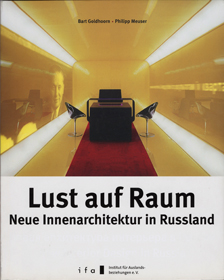
LUST AUF RAUM.
Russian interior design must be splendid and luxurious.
Why did you choose to meet here of all places, and not in your quiet studio?
It was more a coincidence that I’ve chosen this café. In any way, I prefer it to my office. My studio is something like a tool for me, an instrument for my work. And in a way architects’ offices look the same everywhere, don’t they?
Apart from that: do you believe there is a specifically Russian interior design?
Yes, I do think so. For me, interior design is connected with the aspect of rationality, and Russian interior design is extremely irrational, because it primarily relies upon excess and beauty, less on reason. This has to do with the interior designers themselves, but also with laziness. In Germany everybody refers to Neufert, which is around since the 1930s and provides the most important tool box for architects. This set of ergonomic rules delineates a framework for planning. There is nothing similar in Russia at all. Everything happens more accidentally and arbitrarily here. You have an idea, and then you rely on your intuition, not on exact numbers. All that counts is the aesthetic idea, the style.
Your opinion diverges from that of your Russian colleagues who either shake their heads when asked about original Russian interior design, or admit that they have never reflected upon it. What do you think: why do your colleagues refuse the idea of Russian interior design?
This is probably connected with the term. In Russian, there is no word for the English “design”, which also denotes architecture, that is, the creation of objects. The Russian use of the word is more superficial. For us, design is not a creative act but a kind of “work on the existing”. It is the manipulative, altering use of objects and spaces. It is quite an imprecise notion comprising a lot of things: objects of daily use, textiles, clothes. But it is not used in the context of architecture. There is no such thing as “urban design” for us, for example. We talk about urban planning or urban construction. Hence, the notion of “design” is blurred and limited at the same time. It only bears a meaning when referring to objects or graphical products.
If you find the notion “design” too imprecise, could you give a definition of space or spatial design from an architectural perspective?
Do you mean space in the architectural sense or in the concrete sense of an interior?
How do you distinguish this?
Architecture that confines itself to the construction of buildings in the strict sense doesn’t exist anymore. In a broader sense, it comprises all kinds of disciplines that are somehow related to art. Marketing, branding, economy, graphic arts, advertisement. In other words, everything that addresses a consumer or the prospective building-owner. Architecture today has become a kind of interface between space as such and the user. The user determines the action within the space. Architecture offers the design framework, which – in my projects – is in fact determined by myself.
Which style do you pursue in your architecture?
If you ask me about my style, I reply: I don’t have a style. In my opinion styles don’t exist anymore, anyway.
And when you are asked by a customer?
Eclecticism! This term is usually used in a derogatory sense today, in the sense of a non-creative way of working, where you seemingly adopt the ideas of others. But in antiquity this notion indeed had a positive meaning: Cicero for example. He was an eclecticist. This referred to the philosophical method of re-combining acknowledged positive elements from various systems into a new doctrine. Transferred to architecture this means: choose the best from all good examples and compose a new whole of it. At least, that’s how I usually work with my customers. At first I support them in their research for suitable solutions. Then I help them to find the right decision with regards to the design.
For the photo meeting you brought us to the Yelisseyevski department store. There you placed yourself in front of an oversized console. I have the impression that you have a special relation to this historic, even splendid architecture. In which way can a young architect like you be connected with architecture from the era of the tsars?
The Russian language knows the word “naryad”. You use it to describe splendid clothing. But it is also used to describe something luxurious. A room for example. It may often be “splendid” or “luxurious” in Russia. This is less of a problem for us then for you in Germany. Think of the GUM department store, the Kremlin buildings, the architecture from Stalin’s times – or finally the splendid interior design at the Yelisseyevski department store. Architecture should be dressed like a body. And which kind of fashion I dress this body with is not so important. Exactly like for me as a Russian the word “naryad” is no taboo, neither is the architecture of the past, replete with ornaments and rich in decoration, a taboo for me.